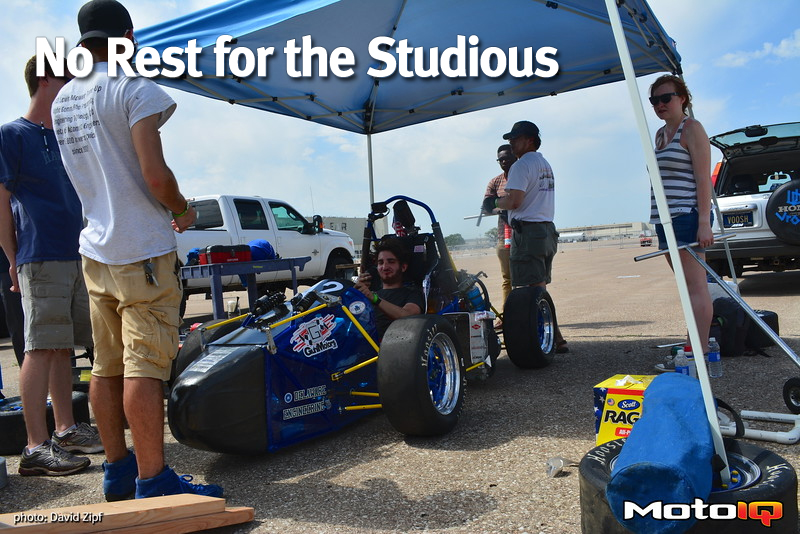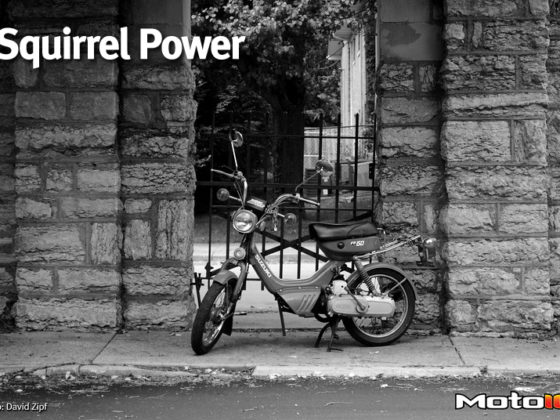,
 A late night thrash and we pulled the car out of the shop to start and warm it up to make sure there weren’t any leaks, as we had test session scheduled for the next day. Basically our week days were non-stop fabrication and construction, and our weekends were driving and dynoing. Our small team was pulling something like 18 hour days 7 days a week for a month straight.
A late night thrash and we pulled the car out of the shop to start and warm it up to make sure there weren’t any leaks, as we had test session scheduled for the next day. Basically our week days were non-stop fabrication and construction, and our weekends were driving and dynoing. Our small team was pulling something like 18 hour days 7 days a week for a month straight. We were still running our early intake at this point. Here you can see the computer fan doing its job on the oil cooler we discussed last time (yes it lights up blue). You can also see our massive brake light that was originally a trailer light. You do NOT want to look directly at it when it’s on. As with almost anything safety related, SAE cars are required to have brake lights Since both of these parts are LED lit, they are low amp draw. The lightweight aluminum mesh covering the muffler is required for any exhaust parts exposed to the driver. Said cover does not have to be solid. So we bought an open style mesh from McMaster-Carr and bent and cut it to shape to add as little weight as possible.
We were still running our early intake at this point. Here you can see the computer fan doing its job on the oil cooler we discussed last time (yes it lights up blue). You can also see our massive brake light that was originally a trailer light. You do NOT want to look directly at it when it’s on. As with almost anything safety related, SAE cars are required to have brake lights Since both of these parts are LED lit, they are low amp draw. The lightweight aluminum mesh covering the muffler is required for any exhaust parts exposed to the driver. Said cover does not have to be solid. So we bought an open style mesh from McMaster-Carr and bent and cut it to shape to add as little weight as possible. It lives! After three weeks of repairing, painting, and rebuilding, we were driving again. You’ll notice the wheels and tires are different than what you’ve been seeing so far. Hankook donated a set of out of production Ventus F200 C91 compound slicks, which are meant for road racing cars much larger than our tiny SAE autocrosser. Since they were free, we put them to good use as testing tires. Our test area is an unprepared concrete pad (originally a warehouse from the old Chrysler plant in Newark), so picking up punctures was somewhat common, even with track walks and sweeps. Good thing one of us knew how to plug a punctured tire. The Hankooks became sacrificial tires, while we saved our brand new Hoosier slicks for competition.
It lives! After three weeks of repairing, painting, and rebuilding, we were driving again. You’ll notice the wheels and tires are different than what you’ve been seeing so far. Hankook donated a set of out of production Ventus F200 C91 compound slicks, which are meant for road racing cars much larger than our tiny SAE autocrosser. Since they were free, we put them to good use as testing tires. Our test area is an unprepared concrete pad (originally a warehouse from the old Chrysler plant in Newark), so picking up punctures was somewhat common, even with track walks and sweeps. Good thing one of us knew how to plug a punctured tire. The Hankooks became sacrificial tires, while we saved our brand new Hoosier slicks for competition.  We actually got the idea to use these tires because we read about them here on MotoIQ where it was mentioned F200s came in 13” sizes. A 180/55-13 is taller and slightly wider than the Hoosier SAE tire we normally use, so we gave it a try. We wanted to try something different and see if we could find an advantage. While they were great for practice, they were too heavy and too hard to heat for competition use.
We actually got the idea to use these tires because we read about them here on MotoIQ where it was mentioned F200s came in 13” sizes. A 180/55-13 is taller and slightly wider than the Hoosier SAE tire we normally use, so we gave it a try. We wanted to try something different and see if we could find an advantage. While they were great for practice, they were too heavy and too hard to heat for competition use. We ran a full day with almost no reliability issues. It was sweet vindication after the dyno setback. Once we were sure the track was clean, we switched to our standard Hoosier’s to scrub them in and get a back-to-back test to see how the times compared to the Hankooks. Between the weeds, dirt, debris, and breaking down concrete, this is a terrible place to test. But it’s wide open and gives us tons of room to set up a course. If you can get a car to handle well here, it’ll handle well anywhere.
We ran a full day with almost no reliability issues. It was sweet vindication after the dyno setback. Once we were sure the track was clean, we switched to our standard Hoosier’s to scrub them in and get a back-to-back test to see how the times compared to the Hankooks. Between the weeds, dirt, debris, and breaking down concrete, this is a terrible place to test. But it’s wide open and gives us tons of room to set up a course. If you can get a car to handle well here, it’ll handle well anywhere.


